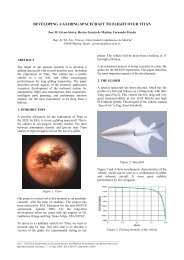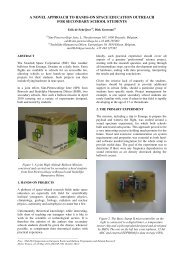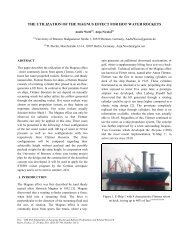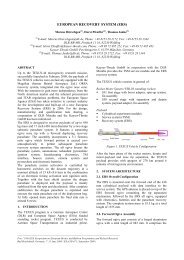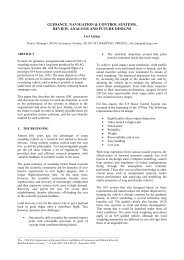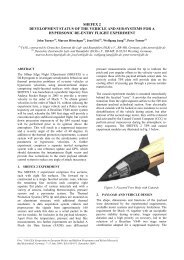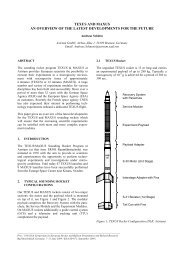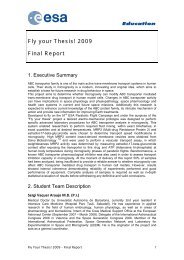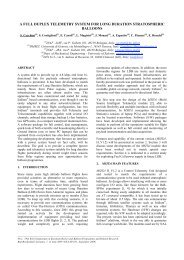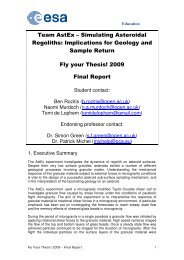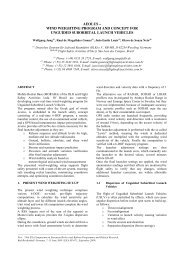D. Abplanalp, P. Wurz, M. Wieser & S. Barabash - ESA
D. Abplanalp, P. Wurz, M. Wieser & S. Barabash - ESA
D. Abplanalp, P. Wurz, M. Wieser & S. Barabash - ESA
You also want an ePaper? Increase the reach of your titles
YUMPU automatically turns print PDFs into web optimized ePapers that Google loves.
thin capillary. However, in a stratospheric application<br />
aerosols and water ice particles could block the thin<br />
tube, making this set-up rather error-prone. We<br />
therefore decided to use instead a bakeable pinhole and<br />
modified a CF-16 flange copper sealing for our<br />
application. The orifice itself consists of a 1 mm thick<br />
disk made of gold-platinum alloy with a laser-drilled<br />
pinhole. The smallest reproducible pinhole had a<br />
diameter of about 20 µm. The disc has been brazed<br />
vacuum-tight onto the copper gasket. Vacuum flow<br />
calculations of the system [5] yields a flow rate of 4.5 ×<br />
10 -6 mbar l s -1 at an outside pressure of 5 mbar.<br />
However, first tests showed a higher flow rate. With an<br />
outside pressure of 5 mbar we obtained an instrument<br />
pressure of 2 × 10 -6 mbar, i.e., close to the upper limit<br />
for the instrument. Reduction of the pinhole diameter<br />
with a special tool under a microscope finally resulted<br />
in an equilibrium pressure of about 7 × 10 -7 mbar at 5<br />
mbar outside pressure.<br />
Outside of the flange with the pinhole, we had mounted<br />
an 11 W heater-foil (Minco ® ), which allowed (if<br />
needed) to heat the flange up to 110 °C within a few<br />
minutes. The heater was planned to melt any ice and/or<br />
aerosols on the orifice in case of a blocked gas inlet.<br />
The gas inlet system consists of a five meter long Teflon<br />
tube to sample the stratosphere far away from the<br />
gondola. A special designed Teflon particle filter is<br />
mounted at the intake side. The filter has two mesh<br />
grids, one with 10 µm and one with 5 µm pore size,<br />
respectively. A small peristaltic pump (Alitea ® ,<br />
400F/M1) with a pumping speed of 150 ml/min is<br />
placed just before the gas inlet to guarantee continuous<br />
gas throughput through the inlet system. It’s flow rate is<br />
sufficient to exchange the complete gas volume of the<br />
inlet system in one minute, which corresponds to the<br />
time interval for data acquisition.<br />
Outside of the experiment box, a right angle inlet valve<br />
(the manual safety valve) was added and was opened<br />
just a few minutes before launch. Inside of the box, a<br />
pressure sensor (Baumer ® , SN 1-15010814-16) and an<br />
electromagnetic valve (Vacom ® , IPVA 10EK-24VDC)<br />
were installed. As soon as the experiment reached the<br />
desired altitude, the electromagnetic valve was opened<br />
and the atmospheric gases started flowing into the UHV<br />
part. For safety reasons, we used a power-off open<br />
valve, which forms a lower risk for operation than a<br />
power-off closed valve and, in addition, does not need<br />
any power during regular operations, i.e., while it is<br />
open. However, with a power-off open valve, an<br />
extreme cold restart of the system results in an open<br />
inlet valve and therefore in gas flowing into the UHV<br />
part, which, in combination with the powered off ion<br />
getter pump, would result in a very quick venting of the<br />
UHV part. In such case, the ion getter pump would not<br />
be able to restart and no scientific data could be<br />
acquired anymore. Such a problem would be critical<br />
especially during the balloon ascend, because in this<br />
period the outside pressure is still too high to start the<br />
ion getter pump. Also a longer power failure within the<br />
measurement phase could be critical, but laboratory<br />
tests demonstrated that we can handle a power failure of<br />
at least 50 minutes. For these tests, we added an<br />
additional pressure sensor in the UHV part and turned<br />
off the power of the ion getter pump at an inside<br />
pressure of 5 × 10 –7 mbar and an outside pressure of 9.1<br />
mbar. After about 4 minutes, the inside pressure<br />
increased to 3 × 10 –5 mbar and continued to increase<br />
exponentially. The maximum startup pressure for the<br />
ion getter pump is 5 × 10 –2 mbar, which corresponds to<br />
a venting time of about 50 minutes without pumping.<br />
For the prelaunch preparations, a CF-40 flange with a<br />
right angle valve was welded on the vacuum tube of the<br />
mass spectrometer, thus the instrument could be<br />
pumped during ground operations with a turbo pump. In<br />
addition, we baked the instrument while pumping with<br />
the turbo pump up to 200 °C, which significantly<br />
reduced the background in the spectrometer.<br />
2.4. Electronics<br />
The aim of the P-BACE/MEAP experiment was to test<br />
the system in conditions similar to Mars or Moon.<br />
Therefore, we designed and built an experimental setup<br />
that is completely computerized to allow for<br />
autonomous operation. The Data Processing Unit (DPU)<br />
is a 600 MHz Celeron-M ® processor embedded in an<br />
industrial PC (MPL, PIP7) with a power consumption of<br />
16 W, an operational temperature range from –20 °C to<br />
+60 °C, and an input voltage of 28 VDC. The storage<br />
medium consists of two 16 GB flash disks, which<br />
redundantly stores all housekeeping and scientific data.<br />
The DPU is extended with a 32 channel (16-bit) low<br />
speed ADC-card (Diamond systems ® , MM-32x-AT), a<br />
16 channel (12-bit) DAC-card (Diamond systems ® ,<br />
RMM-1612), and a Relay-card with 20 relay channel<br />
outputs (Diamond systems ® , IR-104-PBF). For the<br />
scientific data acquisition, we use a full-length PCI<br />
standard high speed ADC-card (Agilent ® , U1082A,<br />
AP240 with averager firmware). In single channel<br />
mode, this card has a sampling rate of 2 GS/s with an<br />
analogue bandwidth of 1 GHz and a vertical resolution<br />
of 8 bits. To record spectra, the card digitizes the<br />
detector signal for 30 µs, which corresponds to a mass<br />
range of 0 – 1,000 amu/q. The averager firmware has up<br />
to 65,536 triggers per segment, which gives a total<br />
vertical resolution of 24 bits. The disadvantage of this<br />
card is the high power consumption (about 70 W) and<br />
the narrow operational temperature range from 0 °C to<br />
+40 °C.<br />
The protection unit is a custom-made part of the<br />
electronic system and consists of a watch dog timer and<br />
a pressure sensor for the high voltage protection in case<br />
of a loss of pressure in the vessel. Several DC/DC<br />
converters in this unit provide the different voltages<br />
needed for the experiment. All ten low voltage power



